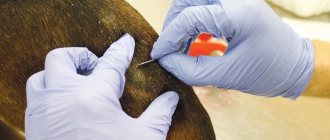Friends, good afternoon!
I want to share a personal story to protect you from the sad, unpredictable, because “who is forewarned is forearmed”!
2010 Then I didn’t yet know that if a cat was bitten by an encephalitis tick, then it was necessary to urgently go to the clinic... And not only that I didn’t know! Please read our previous article: “If a tick bites a cat, how to treat and how to help at home?”
The year turned out to be fruitful and the “silent hunt” was in full swing. My family and I picked baskets full of mushrooms. We returned home in the evening. We were joyfully greeted by a bored kitty. The fluffy beauty frolicked and examined the things she had brought.
She was attracted by unfamiliar forest smells, she cheerfully rustled autumn leaves and blades of grass that accidentally fell into baskets.
I no longer had the strength to sort through and peel the mushrooms. We spread a large piece of polyethylene on the floor in the apartment, poured the rich trophy onto it, rejoiced at it and went to bed.
No one could even imagine that along with the gifts of nature we brought home... an “uninvited guest.”
Only a day later (!) I discovered a formidable forest bloodsucker near my dog’s ear. He had already gotten comfortable in the warm, secret place and sucked in so much that he was almost halfway under the skin, swollen and filled with blood...
What is the danger of parasites?
Ixodid ticks in cats are visible to the naked eye. Once on the pet's skin, the insect digs in with its teeth, secreting saliva containing lyco- and mucoproteins, which are released and become hard, tightly holding the bloodsucker in the epidermis. Saliva contains enzymes that have an analgesic effect, which makes the bite invisible. Ticks carry pathogens of dangerous diseases, so the consequences of a bite are extremely dangerous:
For an animal, this situation can result in infection with Borrelia.
- Borreliosis. The causative agent is the spirochete Borrelia. Spreading throughout the body, it affects skeletal structures, heart, kidneys, and liver. It has several stages of development, bright manifestations are noticeable after 3 months. after a bite. It is severe, especially in kittens, which can die.
- Theileriosis. It occurs due to the single-celled parasite Theileria felis. Symptoms appear after 7-10 days. The cat becomes lethargic, the functioning of the liver and respiratory system is disrupted. Possible death 14 days after the onset of symptoms.
- Piroplasmosis. The causative agent is the protozoan organism Babesia. Feline babesiosis is rarely diagnosed and is more common in dogs. Siamese cats, whose immune systems are weakened, are most susceptible. The cat becomes lethargic, the temperature rises, blood appears in the urine, and paralysis of the paws is observed. Without therapy, animals die.
- Hemobartonellosis. The disease is caused by Rickettsia hemabartonella felis and affects mainly young individuals. The disease can be identified by signs such as jaundice, changes in taste, and impaired respiratory and cardiac activity.
- Tick-borne encephalitis in cats. A tick bite leads to damage to the central nervous system, impaired coordination of movements, nervous excitability, and convulsions. If cats become infected, there is a risk of death or paralysis.
Precautions for humans and other pets
For prevention purposes, you need to use special drops and collars that repel parasites (Clandestine, Merial, Bayer). It is advisable not to let your cat roam, even in suburban areas. If this happens, then be sure to examine the animal at least once a day. My experience suggests that specialized products are not a panacea either. The pet must be examined even if it is walking around in an anti-parasitic collar. The cat needs to be examined every time it comes back from a walk, or not allowed outside at all. My pets were periodically bitten by parasites, although they wore a special protective collar.
The collar is very light, free and does not interfere with the pet’s movement, does not irritate him
You should pay attention to a number of the following recommendations:
- If possible, the bitten cat should be moved to a separate room for a while. For example, in a room where there will be no other animals or people. This needs to be done for at least a few days, so that during this period you have time to wash the skin of your pet. Eggs may remain in the fur, unnoticeable to the owners.
- Be sure to wash the animal's fur, but you should be more careful in lathering the area where the tick has embedded itself. The detergent should not get into the wound. Be sure to use a special anti-parasite shampoo.
- For prevention, you should buy a collar for your cat. It looks about the same as a flea collar. With its help, parasites will not be able to reproduce on the pet’s body.
A person, if his pet has brought an ixodid tick on his body, is recommended to use sprays, creams and ointments against parasites. They are used to treat the skin and spray it onto clothes. Products from the following brands are considered the most effective:
- Gardex;
- Mosquitall;
- Reftamide;
- "Anti-mite tornado."
For preventive purposes, other animals should also wear collars that repel pests. Or you should put special anti-parasitic drops on your pet’s withers. Do not spray spray intended for humans on your pet's body.
Symptoms: how to understand that a bite has occurred?
If infection from the parasite does occur, the pet may behave aggressively towards the owner, and even bite him.
Red beetles are considered safe for humans and animals because they are not carriers of diseases and do not affect the body of warm-blooded animals. Ixodid ticks are terrible for street cats, but a pet visiting the street can also become infected. If a cat brings a bloodsucker, dangerous diseases do not appear immediately. If a parasite is detected, the time of the bite can be determined. A hungry insect is brown and flat, while a tick that has sucked blood is red, white or gray and enlarged in size. The symptoms of any tick-borne disease often initially resemble poisoning. As the pathogens act on the body, the clinical picture is as follows:
- A sharp deterioration in health.
- Refusal to play, food.
- Vomiting or intestinal upset.
- Inflammation of the joints, the appearance of lameness, and sometimes purulent arthritis develops.
- Behavior changes, the cat has become aggressive, does not allow itself to be petted, and bites.
- Soreness throughout the whole body.
- Loss of coordination of movements, “drunk” gait.
- The appearance of blood in the urine.
- Difficulty breathing and irregular heart rhythm.
- Yellowness of mucous membranes.
- Paralysis of the limbs, the cat does not sit and cannot stand up.
- Changes in taste preferences, the pet eats inedible objects, since the pathogenic microorganism acts on the brain.
- Exhaustion, dehydration.
Will a cat's tick fall off on its own?
Many people think that the most painless option, if a tick is already sitting on a cat, is to wait until it falls off on its own. In fact, it is in this situation that the risk of infection is maximum. As a rule, the parasite does not release infected saliva into the victim during the first 24 hours. In the next 24 hours, and especially before it falls off, it does this. This is why it is so important to remove the tick as early as possible.
How long a tick stays (sits) on a cat depends on its age and gender. Young nymphs and males only need a few hours (usually up to 6 hours) to drink blood. Adult females can sit for several days until they get so drunk that they increase in size several times. This is where the common misconception comes from: that males do not bite at all. They bite, but most often they are not even noticed. In this case, both males and even young nymphs can be infected and transmit the infection to the victim.
How to help your pet?
With the help of a simple device, you can get rid of this parasite.
The encephalitis tick in a cat is visible to the eye and is removed with special devices - “Tick Twister”, “Zeken-fix” tweezers, “Trixie” parasite removal kit. Algorithm of actions:
- Treat the skin around the tick with a disinfectant.
- Pick up the insect with a cut on the tool, slightly supporting the parasite.
- Lift the device without squeezing the tick.
- Lightly turn the arthropod, as if twisting it, 2-3 times.
- Pull out the parasite, making sure the head is also removed.
- Lubricate the bite site with an antiseptic.
It is not recommended to lubricate the parasite with fat or crush it. The contents of the body contain dangerous microelements that can cause you to get sick, since they are harmful, toxic and have a negative effect. If you don’t have a special tool, you can pull out the tick with a thread:
- Carefully wrap the tick's neck so as not to tear off its head.
- Rock the bloodsucker with smooth movements.
- If the resistance weakens, slightly pull up while turning.
- After extraction, the insect should be taken to a laboratory for analysis or burned, since the parasite continues to live and can infect again.
First aid for a tick bite
If, when examining a cat, you find a tick attached, it is necessary to remove it to reduce the likelihood of infection and relieve the animal from discomfort. How to properly remove a tick:
- use protective gloves (rubber, silicone or nitrile) during the procedure, and be sure to wash your hands afterwards;
- You can remove a tick using tweezers and special extraction tools that can be bought at a pharmacy (hooks, plates, lasso handles). You need to grab the insect by the head and gently twist it;
You can remove the tick with regular tweezers by grabbing it and turning it to the side. - try to remove the parasite completely, without tearing off the body from the head. The remaining part of the tick in the skin can lead to fester and infection.
A special hook will allow you to remove a tick in a matter of minutes
When removing a tick, remember the following recommendations:
- Never treat an insect with oil or any liquid. As soon as the tick begins to choke, it will spit out some of the blood and saliva back, thereby increasing the possibility of infection;
- try to remove the tick carefully but quickly. If you disturb an insect for a long time, it will try to cling tighter to the skin;
- If the tick is deeply embedded, do not try to scratch it or pick it out. With these actions you will not only not remove it, but also damage the skin.
To remove a tick, it is better to use a lasso handle; pulling an insect with a thread is unsafe
It is not uncommon for the tick to rupture during extraction. If this happens, it is better to give up trying to remove the residue - you can treat the wound with iodine, the body itself will reject the foreign part. But the best way out would be to visit a veterinarian.
After the tick is removed, you need to start treating the wound. Use antiseptics to disinfect your skin:
- hydrogen peroxide;
- Terramycin spray;
- chlorhexidine;
- iodine;
- brilliant green;
- alcohol.
Within a week, the bite site may become inflamed, so you can seek treatment for the wound:
- after disinfection, apply antibiotic ointment (for example, Levomikol, Bioseptin). This will prevent infection;
- After 5–10 minutes, treat the wound with hydrocortisone ointment to relieve itching.
The removed tick must be destroyed. This can be done by drowning it in a small container with alcohol or insecticide. Do not flush ticks down the toilet or sink! Ticks are able to survive in water and continue parasitizing. If possible, submit a live tick to a laboratory for examination - this way you will save your nerves and find out for sure whether the insect is infected or not.
treat the wound with terramycin to disinfect
Treatment: what to do if a cat is bitten by ticks?
If an animal is infected with borreliosis, the antibacterial drug Amoxicillin may be included in the course of therapy.
If a cat is bitten by a tick, treatment is prescribed by a veterinarian depending on the diagnosed illness.
With borreliosis, relief comes from an antibiotic - Cephalosporin, Tetracycline, Amoxicillin. The doctor determines the dosage for a kitten and an adult animal individually. Theileriosis is difficult to treat because there is no cure for the disease. However, the microorganism is affected by the combination of the drugs Atovaquone and Azithromycin, as well as products containing diminazine aceturate and imidcarb dipropionate. Treatment of a cat for piroplasmosis includes antimalarial and antiviral drugs. To restore the immune system and strengthen the body, it is recommended to give immunomodulatory medications and vitamin-mineral complexes. If the limbs are affected, massage and physiotherapy are recommended to improve the mobility of the paws.
Where do ticks spend the winter?
During the winter, ticks hibernate. Their comfortable time - warm and humid - gives way to cold weather. They choose deciduous forests, where they can burrow into the depths of fallen leaves until spring. However, spring for ticks can come much earlier than the calendar year.
As soon as the temperature rises to 0 ℃, the parasite awakens and goes in search of food. Therefore, if in your region the temperature does not drop below 0 ℃ and the snow does not linger on the ground, you cannot lose vigilance all year round!
The same is true if you and your pet walk near heating mains. There, ticks don’t experience winter at all, because it’s warm and damp all year round.
Be careful in winter! And when the weather warms up, don’t forget about prevention.
Prevention
It should be remembered that the tick lives not only in the grass, but the owner can also bring it into the house on street clothes. Therefore, when coming from the forest or after a walk in a green area, it is recommended to shake out things before entering the room. If your pet visits the street, after returning you should examine the neck, behind-the-ear space, abdomen, groin area, and armpits. In order not to catch the bloodsucker, the cat should be washed and treated with antiparasitic agents “Amivet”, “Api-San Dekta”, “Vectra Felis”, “Frontline Combo”, “Green Fort Neo”, “Inspector”, “Merial Broadline”. For cats that walk for a long time, collars “Frontline”, “Beafar”, “Foresto”, “Bolfo” are suitable.
Possible consequences
The danger of ixodid ticks is not their painful bites, but the fact that they are carriers of various diseases. Here are some of them:
- viral encephalitis;
- piroplasmosis;
- hemobartonellosis;
- theileriosis.
It is quite possible that a sexually mature female will lay eggs on the animal’s body. Therefore, it is imperative to carefully examine the skin of your pet for pests. If they are found, the cat must be washed with special products. Previously, I washed the animal with regular cat shampoo, but the veterinarian advised me to buy an antiparasitic one.
Features for pregnant cats and kittens
Tick bites are especially dangerous for pregnant and lactating cats and kittens. Animals' immunity is weak, and infections transmitted through the parasite's saliva are especially dangerous. They can provoke premature birth and lead to the death of the offspring. At the first suspicion, it is necessary to find and remove the tick. You should not ignore a visit to the veterinarian, the health of the expectant mother and her cubs depends on it.
A kitten can become infected from a nursing cat
Subcutaneous bloodsuckers
The habitat of subcutaneous (Demodex) or scabies mites in cats is the upper layers of the skin and hair follicles, areas of weak pubescence: the head, paws, areas around the eyes. Cat mites can live on an animal for many years, feeding on dead epidermal cells and without harming the pet.
Manifestations of the disease become noticeable when the pet’s immunity decreases. You can tell from the symptoms that your cat is sick:
- the animal begins to constantly itch and becomes irritated;
- on the affected areas, hair falls out, even to the point of baldness;
- Scratching appears until there is blood, crusts, and blisters with pus.
Increased activity of the demodex mite causes the skin disease demodicosis in the animal.
Subcutaneous mites can infect humans as well as dogs, but cats are more susceptible to this danger. Parasites cause the following diseases in cats:
- Demodicosis - affects the upper layer of the skin with constant itching and allergic reactions.
- Feline mange, or notoedrosis, causes ulcers to form first on the head and then throughout the body, causing severe itching and hair loss. The disease can be transmitted to humans and other animals.
- Cheyletiellosis is a type of profuse dandruff with a mass of microscopic mites. It manifests itself as scaly nodules on the skin of the back and hair loss. Humans can become infected with this disease.
- Sarcoptic mange is the formation of scabs and crusts. At the beginning of the disease - on the face, then the whole body is affected, and unbearable itching occurs.
Subcutaneous mites can cause a range of skin diseases in both animals and humans.
Treatment is carried out only after a correct diagnosis, depending on the type of parasite, tests and scrapings from the disease-affected areas.
Sometimes the disease takes on an advanced form, and then treatment will require a lot of time and perseverance to perform various procedures:
- baths with keratological shampoos;
- cutting hair on damaged areas and applying Fungin, Saphroderm, Amitrazine ointment;
- a course of antibiotics prescribed by a doctor;
Give your pet antibiotics only after consulting a veterinarian - the use of vitamins and supplements to improve immunity and accelerate wound healing;
- carrying out treatment of animals that have been in contact with the sick person;
- disinfection and disinsection of premises and care items with acaricidal solution Delta Zone, etc.
The result of treatment depends on the severity of the disease. In mild cases, self-healing often occurs, and proper nutrition and careful care will further strengthen the pet’s immunity.
Diagnostics
After each walk, it is necessary to inspect your pet’s body for the presence of ticks. The examination should begin with the head and neck, armpits and between the pads of the feet. After the insect has had time to drink blood, the parasite disappears on its own. Then the animal begins to itch and feel discomfort. A sign that an animal has been bitten is the presence of a reddish swelling or bump on the body.
The cat lost his voice: reasons and what to do
Important! If a tick is found, it must be removed as quickly as possible. A scraping should be taken from the bite site to prevent infection with dangerous diseases.
Preventive measures
It is absolutely impossible to protect your pet who regularly walks outside. However, there are currently types of products whose use reduces the risk of contracting diseases from ticks. These include:
- A collar for cats that repels fleas and ticks is a leather or fabric strip impregnated with a special product. Collars are highly toxic, so they should not be used on kittens, pregnant or weakened animals. The devices are used for healthy cats and cats that spend a lot of time outside and sleep separately from people.
Anti-tick collars for cats protect the animal from parasites for quite a long time - Sprays for cats against ticks are effective, but not very convenient to use. The substance should be distributed, treating the entire surface of the body, and since the animal will begin to lick itself, you will have to hold it for some time until the spray dries. The following types are used: Rolf Club, Hartz, Frontline.
- Flea and tick drops. They should be applied to the skin in the withers area. Absorbed into the skin, the product repels or kills bloodsuckers. After application, the drug has an effect for 1-3 months. This is the most effective and easy-to-use option. High-quality drops Stronghold and Advantix are used for pregnant cats and kittens.
Fighting ticks is necessary in various ways, but it is better to try to prevent attacks by parasites. The use of these products on cats will allow you to repel the attacks of bloodsuckers from the second half of spring until autumn, although it does not provide a 100% guarantee.
What not to do
It is strictly forbidden to work with bare hands; you must wear rubber gloves; all tools must be disinfected. When removing the parasite, you must adhere to safety measures:
- You cannot make sudden movements, otherwise you can tear your body away from your head. If this happens, the bite site must be treated with brilliant green, the head will fall off on its own after a while;
- Do not use oils, kerosene, petroleum jelly, or ammonia. The tick may suffocate, making the removal process difficult;
- When scrolling, you need to try not to crush the insect. Liquid from the parasite's crushed abdomen gets onto the skin, and then infection cannot be avoided.
Important! When extracting a parasite, you should not squeeze it out, other than suffering, this will not give anything to the cat.











